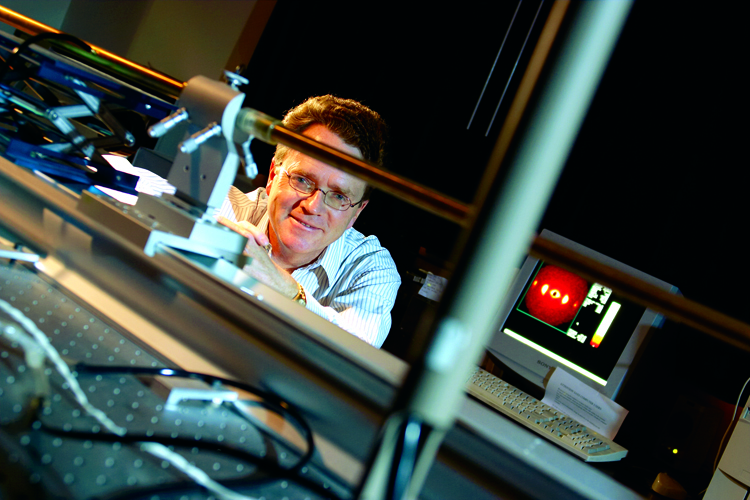

Main navigation | Main content
01/13/2015
Recent research from the research group of Professor
Funding continues for one of the university’s oldest and largest multi-disciplinary research centers. The National Science Foundation (NSF) has renewed, for the third time, grant funding for the 16-year-old Materials Research Science and Engineering Center (MRSEC). The new six-year grant is $17.8 million.
The University’s MRSEC, one of about 25 such centers in the country, is directed by Timothy Lodge, a Regents Professor in both the Department of Chemistry and the Department of Chemical Engineering and Materials Science. It was originally funded in 1998, with grants renewed in 2002 and 2008.
NSF MRSECs support interdisciplinary and multidisciplinary materials research that addresses complex problems in science and engineering, which are important to society, and which could not be addressed under traditional funding of individual research projects.
MRSECs are somewhat unique: there is no maximum on the number of times that the NSF can renew funding; and research is not focused on one broad topic. Instead, the research can focus on different issues. With the new funding, the University’s MRSEC has three distinct foci, clustered in what are called Interdisciplinary Research Groups (IRG). They will involve 27 faculty researchers from five different departments in the highly-collaborative College of Science & Engineering, including Chemistry, Chemical Engineering and Materials Science, Electrical and Computer Engineering, Mechanical Engineering, and Physics.
Professor Chris Leighton from the Department of Chemical Engineering and Materials Science is coordinating the research group, Electrostatic Control of Materials, looking at how organic and inorganic materials such as ionic liquids, ionic gels and solid electrolyte structures can possibly generate new technologies such as plastic electronics and magnetic storage devices.
Professor Uwe Kortshagen from the Department of Mechanical Engineering is coordinating the research team, Sustainable Nanocrystal Materials. This team will concentrate on developing nanocrystals made from non-toxic, environmentally benign and earth abundant elements such as silicon, germanium, copper, and zinc, which can be assembled into thin films for solar energy conversion and low energy lighting. Chemistry Professor Christy Haynes is one of the researchers exploring the environmental stability and toxicity of new nanocrystal materials.
Professor Theresa Reineke from the Department of Chemistry is leading the third IRG, Hierarchical Multifunctional Macromolecular Materials, concentrating on assembling polymeric materials with superior properties that can be used for a variety of diverse applications such as water treatment, fuel cell membranes, gene therapy, and intricate circuit manufacturing. Department of Chemistry professors Lodge, Marc Hillmyer, and Ilja Siepmann will also be involved in a number of specific research efforts in this IRG.
The University’s MRSEC also helps researchers with its seed program, providing grants of $50,000 for innovative research. These competitive seed grants support junior faculty and investigators changing fields who are engaged in high-payoff research projects or projects encompassing emerging areas of interdisciplinary research. For example, Assistant Professor James Johns from the Department of Chemistry is receiving a seed grant to research the ultrafast photoemission of suspended 2D materials. It is not unusual for seed funded research to ultimately blossom into major research initiatives. For example, two of MRSEC’s new IRGs originated with seed funding.
“Our researchers are engaged in cutting-edge materials science research,” said Lodge. They are aided by the strong collaborations in the departments, among the different disciplines that their research represents, and by the shared facilities that are available at the University of Minnesota such as the Minnesota Supercomputing Institute, the CSE Characterization Facility, and the Minnesota Nano Center. The majority of MRSEC’s researchers are also engaged with the University’s Industrial Partnership for Research in Interfacial and Materials Engineering (IPrime), which fosters relationships with industrial scientists. More than 40 industrial partners are involved with IPrime.
Education of and outreach to the next generation of scientists is a top priority for the University’s MRSEC. More than 20,000 K-12th grade students are invited to the University each year for entertaining shows, such as Physics Force and Energy and U, that illustrate fundamental principles of chemistry, physics and engineering. MRSEC offsets all or some of the busing costs for the schools that attend these shows: many would not be able to do so without this funding.
In addition, the MRSEC researchers offer a variety of week-long summer camps for high school students, including a new Materials Weeks for Native American students. Many of the researchers also provide undergraduate research experiences for promising students from a national network of four-year colleges, minority-serving institutions, tribal colleges, and research universities.
To read the University of Minnesota's official news release about this renewed funding for MRSEC, go to http://www.chem.umn.edu/news/news.lasso?serial=843. This story is also published on the university's research website.
Timothy Lodge, a Regents Professor in both the Department of Chemistry and the Department of Chemical Engineering & Materials Science, is director of the Materials Research Science and Engineering Center. Photo by Patrick O'Leary.
